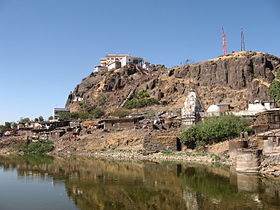Pavagadh Hill
| Pavagadh Hill | |
|---|---|

Summit of Pavagadh Hill
|
|
| Highest point | |
| Elevation | 800 m (2,600 ft) |
| Coordinates | 22°28′00″N 73°30′02″E / 22.46672°N 73.50048°ECoordinates: 22°28′00″N 73°30′02″E / 22.46672°N 73.50048°E |
| Geography | |
|
Panchmahal district, Gujarat, western India
|
|
| Parent range | Vindhyachal Range |
| Geology | |
| Mountain type | Hill |
| Last eruption | 500 million years ago |
| Climbing | |
| Easiest route | Ropeway |
Pavagadh Hill is situated within a plain in Panchmahal district, Gujarat, western India. At its base is the historical city of Champaner, while the hill station of Pavagadh was built upon the volcanic cone itself. A volcanic eruption occurred here approximately 500 million years ago and the etymology of its name is associated with eruption: Pavgadh means "one fourth hill" or "fire-hill", though a legend surrounding its formation is that the right foot of Sati is believed to have fallen at Pavagadh and God "sent a large hill as per the request of Rishi Vishwamitra to fill up a deep valley so that the sage's cows do not fall into it." With Champaner, Pavagadh hill forms the Champaner-Pavagadh Archaeological Park, which is spread over an area of more than 1,329 hectares (3,280 acres). The site is 50 kilometres (31 mi) east of Vadodara and 42 miles (68 km) south of Godhra.
The hill is a southern Aravalli Range outlier, rising 800 metres (2,600 ft) above the surrounding plains. The Dhadhar River and Vishwamitri River originate on the hill. The Surya stream, which also rises on the hill, joins the Vishvamitri. There are five successive plateaus, Kalikamata Plateau, Mauliya Plateau, Bhadrakali Plateau, Machi Plateau and Atak Plateau. Plateau reservoirs (talaos) form a chain up the hill. Other features include dense forest, reddish-orange rhyolite boulders, and a natural cave just below the summit. Strong monsoon breezes blow winds upwards onto steep hill slopes.
The arrangement of the rock formations of Pavagadh Hill is stated as being "rhyolite, green bedded tuffs, porphyritic basalt, olivine dolerite and nonporphyritic alkaline basalt." There are steep rock exposures whose geological formation is attributed to ancient volcanic eruptions and lava flows. Pavagadh Hill has a geological setting of reddish-yellow coloured stone, and is considered to be one of the oldest rock formations in India.
...
Wikipedia

